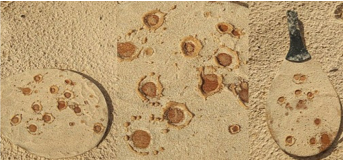IPT Problems 2022
Click here to download the IPT 2022 Problem list in PDF format.
If you have any questions about the list, or if you feel that some problems need clarifications, please write to us using the contact form. We will publish your questions and our answers below each problem.
Release date: Sept. 10th, 2021.
Last revision: Sept. 10th 2021.
All the problems, to stimulate a good discussion, have been formulated as open physics questions. That’s why the statement is never too stringent and it is assumed that every phenomenon will be studied both theoretically and experimentally (when possible) with dependence on all the most relevant parameters. More than that, there is not any general understanding of the task condition. If your interpretation of a certain problem condition corresponds to the written one and is interesting enough and your investigation is challenging and broad – the jury members will most likely award you with the nice marks. Surely, your team is not expected to spend years on every problem. So you should carefully consider your time budget and choose the most important and interesting parameters to study together with doing your best on both the theoretical model and experimental confirmation.
- Physics of Math
Build a device (no calculators and computers please) that can be used to compute some famous mathematical constant in the most physically ingenious way. Optimize the accuracy of your device. Note that there are, in addition to for instance π or e, many other interesting constants such as Apery’s or Feigenbaum’s constants.
Example for π:
- Airbounce
When a Frisbee is thrown in a certain way it can be made to bounce in mid-air. Study the physics of this phenomenon.
- Noise FM
Amplitude, frequency and phase modulations are old robust methods to transfer information via electromagnetic waves. Propose a method to encode information in such a way that the signal will be indistinguishable from the background noise for an uninformed outsider. Propose and implement a setup giving maximum transfer rate and signal-to-noise ratio at some transmitter-receiver distance. - Filled Ball
A ping-pong ball that has been partially filled with some fluid or sand will bounce much lower than a filled one. Explain this phenomenon. How does the height of the bounce depend on the relevant parameters?
- Sparkler
Investigate the burning process of a sparkler. How far can the sparks fly? What determines the size of the flame?
- Flat Earth
Propose an experiment using only a camera and/or the sensors of your smartphone to prove or disprove the flat Earth hypothesis. Using the same equipment, estimate the size of the Earth with as high accuracy as possible. - Washboard roads
When an unpaved road (usually sand or gravel) is used by many cars, a wavy pattern is formed causing strong discomfort for the drivers. Study how the wave parameters depend on the properties of the granular material and on the average speed of the cars. Is there a safe way to drive fast on this type of road?
How are corrugations formed?
- Ferrofluidic patterns
When a ferrofluid is placed in a rotating magnetic field, strange patterns may appear. Investigate the shape of these patterns and characterize them in terms of the relevant parameters.
- Electrostatic lighter
Ancient people used to make fire by rubbing wood. Propose an alternative setup, based on electrostatic effects, made from materials available to Bronze age people. Make a device capable of setting fire using just static electricity in the shortest time possible to a piece of wood. - Droplet sandy fingerprints
When droplets fall on a surface covered by a layer of sand, interesting patterns are formed. Study the formation process. What parameters of the droplets can be inferred from the resulting crater?

- Smashing spheres
Smashing two steel spheres together with a paper in between at the point of collision, produces enough heat that it burns off the paper. Conducting the same experiment with aluminium foil, you will observe concentric rings on the foil after collision. Study this phenomenon. Can it be observed for other materials?
- Inverse coffee cup vibration problem
If you tap the top of a coffee cup with a spoon you will notice that the sound strongly depends on where you tap. Knowing the cup geometry one can predict the frequency spectrum of the emitted sound when tapping at different points. Consider now the inverse problem and find an experimental technique to reconstruct the cup geometry from the emitted sound. What is the minimal knowledge about the cup geometry needed to make the problem solvable?
- Chaotic magnetic pendulum
Consider a pendulum consisting of a magnetic bob attached to a string. If the pendulum is allowed to swing over a structure of permanent magnets, it will display complex motion. Study the pendulum dynamics and its dependence on the number of permanent magnets and their arrangement.
- Rising in the bulk
If a vessel containing granular material is shaken appropriately, an item placed at the bottom will ascend upward through the material and emerge at the top. Explain the phenomenon and devise the most energy efficient shaking technique to raise the item up.
- Galileo method
What is the maximum height a piece of chalk might be dropped without breaking for a given surface? Which parameters does the height depend on? Are there any dropping or throwing techniques which minimize the breakage probability? - Midnight Special
Liquid crystal displays can be used as diffraction gratings. What information about the display structure can be retrieved by studying the diffraction pattern? This could comprise pixel density, subpixel structure, pixel shape and fabrication technology.
- Resistor thermodynamics
Thermal electrons in a resistor can be treated as a closed thermodynamic system where the electrons are interacting with the rest of the conductor held at finite constant temperature: https://doi.org/10.1103/PhysRev.32.110
Create an experiment which allows you to investigate the thermodynamic properties of such a system using an electronic signal. Which thermodynamic quantities can you measure?
Many thanks to all the people who contributed to
the problem list and helped with the problem selection!

